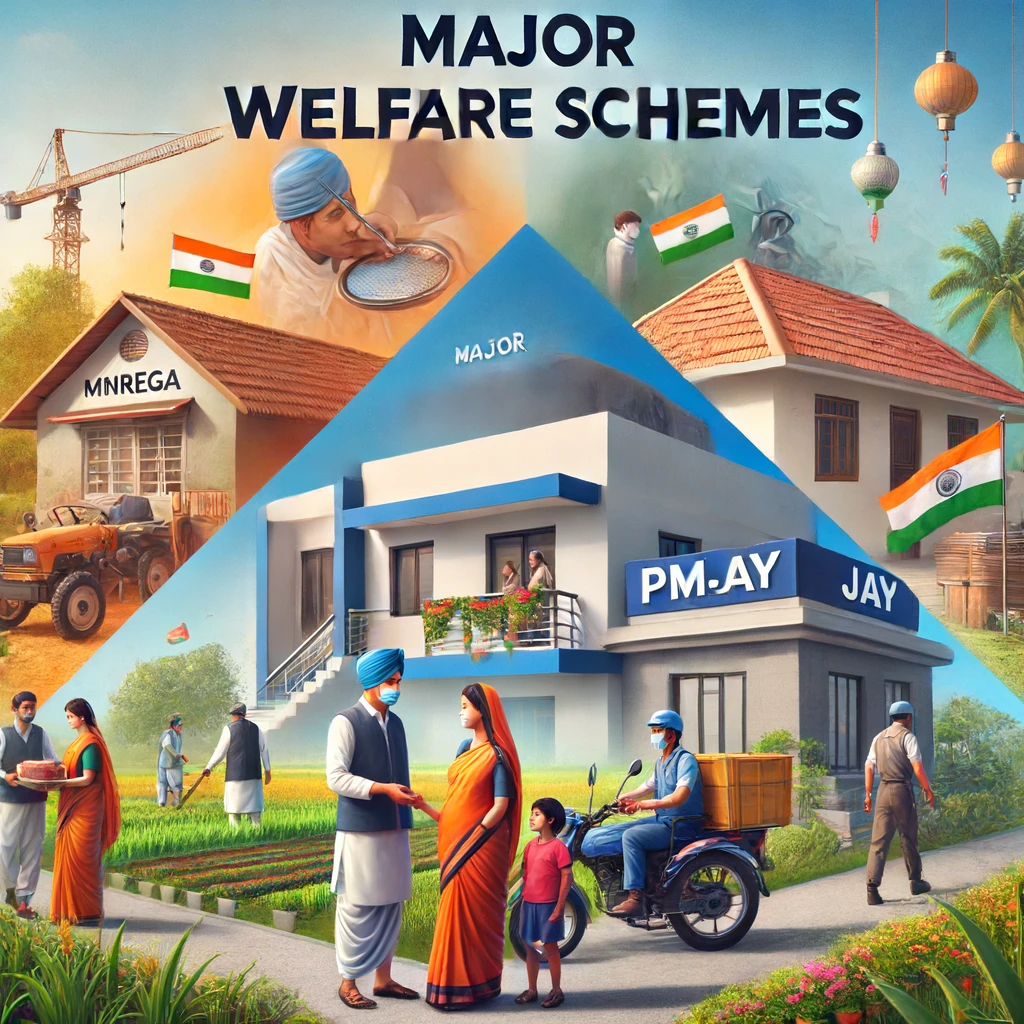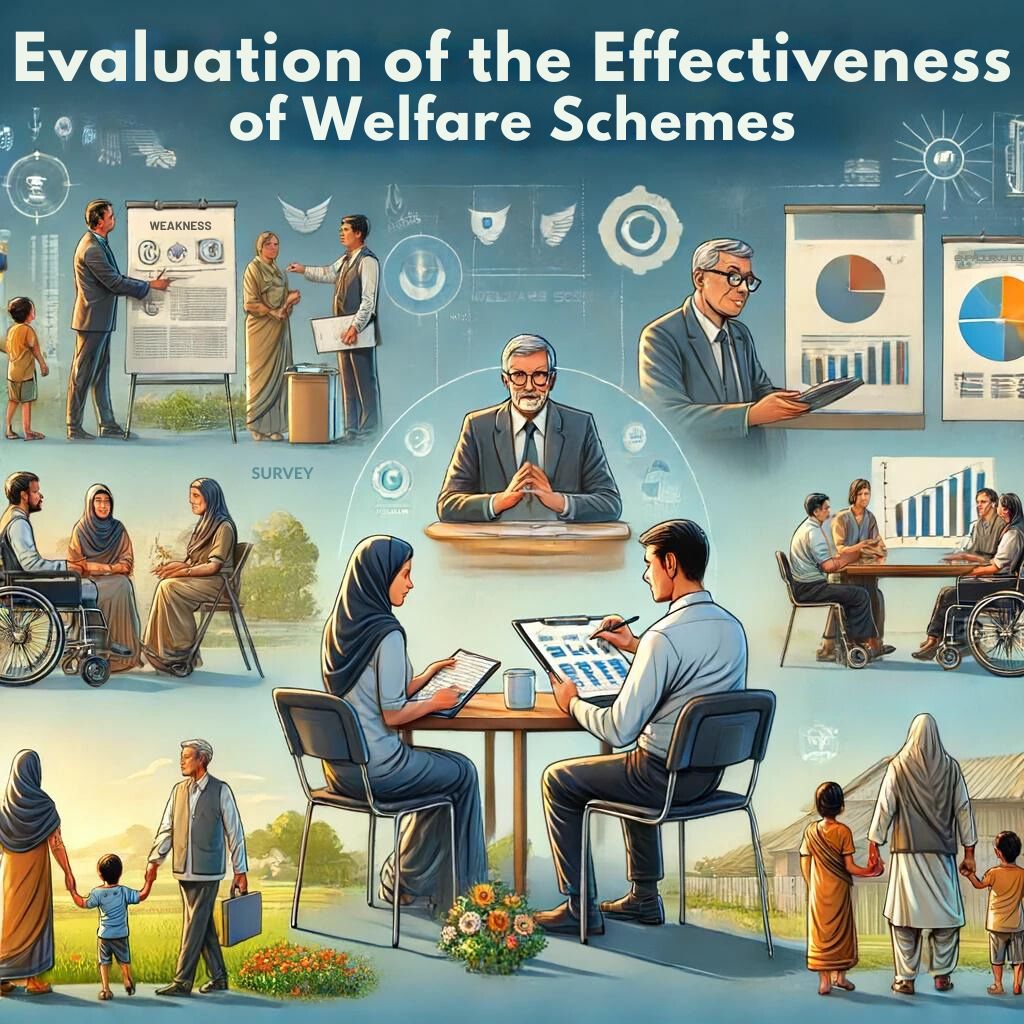Welfare Schemes in India have been largely a part of policy initiatives for uplifting and strengthening marginalized communities and ensuring that growth becomes wholly equitable for the nation. This includes broad areas such as health, education, employment, and social security. Hopefully, by dealing with poverty and inequality in these areas, this would ultimately contribute to the general well-being of all people. The following are some of the key areas covered under Welfare Schemes in India:
- That enhance access to education, reduce dropout rates, and provide hopes for the world’s most disadvantaged children.
- Rural and urban livelihood skills improvement programs that generate employment.
- Provision of social security for the elderly, women, and other vulnerable people.

Overview of Welfare Schemes in India
There have been welfare schemes in India that have been aimed at lessening socio-economic challenges through supporting citizens with health care, education, gainful employment, and social security for the betterment of socio-economically underprivileged households and in fact, to facilitate an integrated, sustainable development of the country as a whole.
Historical Background and Evolution
The welfare schemes of India date back to the pre-independence era when the British government started some welfare-related programs. However, the real boost came after the independence of India with the Indian government focusing on poverty elimination, education, health, and employment generation. The schemes went through various changes throughout the years in their implementation and focus to cater to the changes required by the population and to benefit specific categories more effectively.
Key Objectives and Target Groups
In India, such welfare schemes basically aim at eradicating poverty and providing employment opportunities, improving health and education facilities, and extending social security. The target includes varied categories under the schemes like the poor, women, children, aged, handicapped, and socially deprived.

Major Welfare Schemes
Major welfare schemes of the Indian government improve the quality of living, health, education, and social security. It aims to reduce poverty, create employment opportunities, and ensure fair growth with a good quality of life for all.
Mahatma Gandhi National Rural Employment Guarantee Act (MGNREGA)
- Objective: It enhances the livelihood security of the rural population by providing at least 100 days of wage employment to every household whose adult members volunteer to perform unskilled manual work.
- Impact: MGNREGA, launched in 2005, has given huge momentum to employment in rural India and infrastructure development. It has given millions of rural households a regular income and reduced poverty in villages.
Pradhan Mantri Awas Yojana (PMAY)
- Objective: PMAY aims to provide affordable housing to the urban poor with a target of building 20 million affordable houses by 2022.
- Impact: The scheme has facilitated access to affordable housing, improving living conditions for millions of urban poor. It also stimulates the housing sector, generating employment and boosting the economy.
Pradhan Mantri Jan Arogya Yojana (PM-JAY)
- Objective: PM-JAY, under Ayushman Bharat, aims to provide health insurance coverage of up to INR 5 lakh per family per year for secondary and tertiary care hospitalization.
- Impact: PM-JAY has made healthcare accessible to over 500 million people, reducing out-of-pocket expenditure and providing financial protection against catastrophic health costs.
Financial and Operational Mechanisms
Financial and operational mechanisms are strategies and processes for managing resources to run smooth operations. They focus on budgeting, resource allocation, efficiency, and attaining organizational objectives with a high level of financial stability.
Funding Mechanisms and Budget Allocations
Welfare schemes are mostly funded through the central and state governments. The allocations in the budget vary every year as the priorities and the fiscal capacity change. For instance, the Union Budget 2023-24 allocated Rs 60,000 crore for MGNREGA, thus showing the commitment of the government towards a regular flow of income to its rural population.
Implementation Strategies and Administrative Structure
This also entails the implementation of welfare schemes by several groups, such as stakeholders ranging from central and state governments to local bodies and NGOs. In this regard, an effective system of administration must ensure the effective implementation of welfare schemes with mechanisms of monitoring and evaluation to trace progress and challenges.
Success Stories and Case Studies
The success stories and case studies illustrate in very practical examples of real-life achievements and challenges, evidence of the best in innovative solutions, hence providing a much-needed source of insight for learning from improvement in strategies and drive into positive outcomes.
Successful Implementation at the Grassroots Level
Besides that, MGNREGA has also greatly transformed the Rajasthan rural landscape by creating durable assets in the form of roads, ponds, and irrigation facilities. The other important implication of this scheme is that it has empowered women by providing them with close-to-home employment opportunities.
Stories of Beneficiaries
PMAY brought Lakshmi, who hails from Uttar Pradesh and earns her living through daily wage labor, out of a crumbling shack for the first time in her life to possess a pucca house. The scheme now accommodated her eligibility for the subsidized loan to shift out from a crumbling hut into a safe, secure house.

Critical Analysis and Recommendations
Analysis is meant to examine the strengths and weaknesses of policies or initiatives, putting forth ideas for improvement. Recommendations form a basis for better oversight in improving effectiveness, ensuring better outcomes, and handling gaps or challenges that might exist.
Evaluation of Effectiveness
While welfare schemes have improved considerably over time, leading to the enhancement of socio-economic conditions of the poor, there are still areas of failure because of corruption, leakage, and inefficiency-the case of MGNREGA, where payment delays and misuse of funds have been experienced.
Suggestions for Improvement
To enhance the efficiency and impact of welfare schemes, the following measures are recommended:
- Strengthening Monitoring Mechanisms: Use technology to track implementation and reduce leakages.
- Community Participation: Involve local communities in planning and monitoring to ensure schemes address their actual needs.
- Capacity Building: Train local officials and beneficiaries to improve the implementation and utilization of schemes.
- Regular Audits: Conduct regular audits to ensure transparency and accountability.
- Policy Reforms: Continuously update policies based on feedback and changing socio-economic dynamics.
Conclusion
Welfare programs in India are one of the crucial instruments for the promotion of inclusive growth and social justice. They contribute, in a manner of speaking, to the all-round development of the nation by catering to the needs of the most vulnerable section of society. Much is left to be done for the problems at hand and to scale up welfare benefits by these schemes. More measures as recommended can further strengthen the programs as the benefits will trickle down to needy persons.
| Welfare Schemes in India UPSC Notes |
| 1. Welfare schemes in India aim to reduce poverty, promote social inclusion, and provide safety nets for vulnerable populations across sectors like health, education, and employment. 2. The Pradhan Mantri Jan Dhan Yojana has revolutionized financial inclusion, with over 470 million bank accounts opened, improving access to financial services for the unbanked. 3. The Mahatma Gandhi National Rural Employment Guarantee Act (MGNREGA) guarantees 100 days of wage employment annually, focusing on rural development and reducing poverty. 4. Ayushman Bharat is the world’s largest healthcare initiative, offering health insurance coverage to over 100 million families, addressing healthcare affordability and access. 5. Pradhan Mantri Awas Yojana (PMAY) seeks to provide affordable housing to all by 2022, with urban and rural components ensuring shelter for economically weaker sections. 6. National Food Security Act (NFSA) provides subsidized food grains to nearly two-thirds of India’s population, ensuring food security and reducing malnutrition. 7. Mid-Day Meal Scheme is a crucial welfare initiative aimed at improving nutrition among school children, thereby increasing school attendance and addressing malnutrition. 8. Deen Dayal Upadhyaya Grameen Kaushalya Yojana (DDU-GKY) focuses on rural youth employment by offering skill training and enhancing their employability in various sectors |


